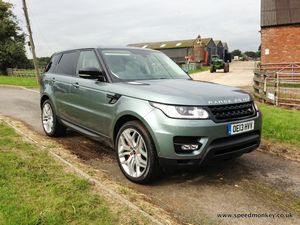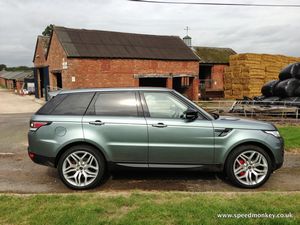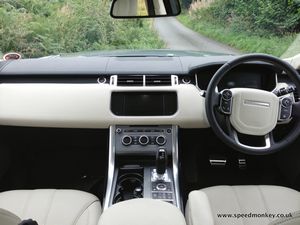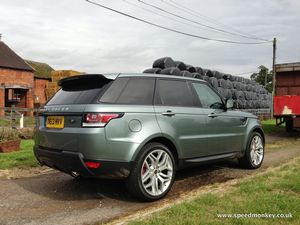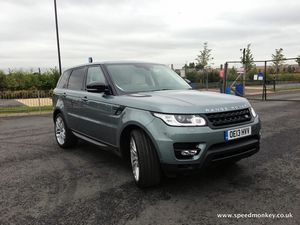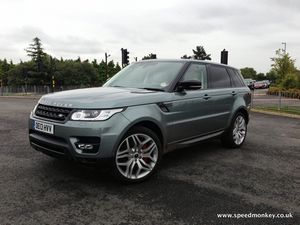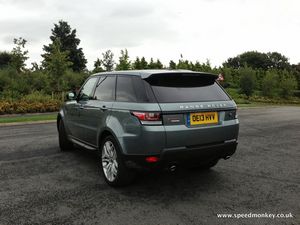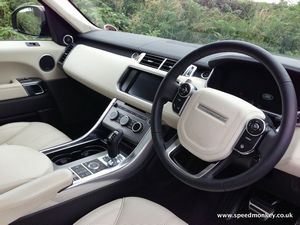|
By accessing or using The Crittenden Automotive Library™/CarsAndRacingStuff.com, you signify your agreement with the Terms of Use on our Legal Information page. Our Privacy Policy is also available there. |

2013 Range Rover Sport review
|
|---|
|
|
2013 Range Rover Sport review
Matt Hubbard
Speedmonkey
September 23, 2013
The 2013 Range Rover Sport is as different from the old Range Rover Sport as the BMW Mini is from the Morris Mini.
Nothing was carried over from the old Range Rover Sport. The old Sport was based on the Discovery chassis whilst the new Sport is based on the new Range Rover chassis. This means it is lighter, to the tune of 420kg, and you don't feel like a nouveau riche plonker driving it.
You'll also have a lot less buttons to press. Literally. Whilst the dash in the old Sport looked like Land Rover had loaded a blunderbuss with knobs and shot the interior, the new one takes a median approach. It has some knobs on the dash and a few functions in the touchscreen, but it has too many buttons and dials on the steering wheel.
It is now harder to differentiate from the new Range Rover. The main giveaway is that the Rangie gets fake gills on its doors whilst the Sport doesn't. Many people report that the Sport now looks a bit like the Evoque. But I disagree. That's just lazy journalism.
Sure the front end is vaguely Evoquesque but that's all. The Evoque is squat and quite square, with a low roofline that tapers to almost nothing at the rear. The Sport is tall, long and quite rounded. There aren't too many sharp edges on it. It's handsome, brand new, but recognisably a Land Rover.
The test car sat on 22" wheels but given it's size (4.78m long, 1.93m wide, 1.81m tall) they don't look out of proportion. It is a big car but it's designed so well it doesn't look massive to the naked eye.
Take a look at the photo above. See the lower skirts, the black bit below the door? When you open a door you realise that bodywork is actually part of the door, and opens with it. This reveals the usual Land Rover flat floor and flat floor (so mud and dirt can fall out when alighting whilst wearing wellies). It also means the sill is clean because it is normally covered by the door. No mud on the sill to get your clean trousers and shoes dirty. Cleverly thought out and incorporated into the car. This is why Land Rover is Land Rover.
Once inside and it is almost identical to the new Range Rover. The interior is laid out the same. You would struggle to know which car you were in. The Range Rover is bigger in every way than the Sport but the only differences you feel inside are in width and windscreen rake. The Sport is about 15cm narrower and the windscreen is set at a less steep angle. The Range Rover adopts quite a traditional, flat windscreen whilst the Sport's is more fashionably shallow.
Visibility is fantastic. You sit high up, with lots of headroom above (infinite if you open the vast sunroof), and the A-pillars are positioned and designed so as to minimise visual impact.
The aforementioned controls are nicely laid out. The Start Stop button is at the top of the dash by the vents. There are 3 knobs under the touchscreen which control the climate system and around these are some other buttons for the entertainment system.
The screen is the usual Jaguar Land Rover effort but with flush buttons that are similar to a smartphone's screen. I prefer Jaguar's actual buttons. They look less posh but have a more positive actuation. The touchscreen controls satnav, heated seats, entertainment and some of the climate systems.
Again, I've read other people talk about the touchscreen system being counterintuitive and confusing but this is absolute rot. It's a doddle to use, and the satnav is a good one. You just have to put in a small amount of effort to understand it, then everything becomes second nature.
The gear lever is the same as in the F-Type and is apparently based on that a typhoon fighter. It looks nicer than the old dial (and the one you'll still find in the XF) but it's less easy to use and the trigger (which you have to pull to make it function) is gimmicky and superfluous.
Eleswhere you get a mass of storage space and a USB plug, and fridge under the armrest. I like this. The Sport is ideal for long journeys so you can chuck your bottle of water and can of Red Bull in the fridge and not have to pay ridiculous motorway service station prices for them.
The seats are supportive, comfy, infinitely adjustable and just very nice to sit in. The headrests in particular just meet the back of your head. In most cars the headrest sits somewhere behind your head but in the Sport they gently brush against it, and when you lean back you feel they are very squidgy. They'd do a good job of cushioning your bonce in a crash.
The rear seats are vast. Three could sit abreast with no problems, although the middle occupant might feel left out whilst his companions watch telly on the integrated TV and headphones (a £1,500 option). Plenty of knee room is available for anyone up to about 7 foot tall.
Elsewhere the trim is leather, aluminium and piano black. No wood at all in the car I drove.
Fire up the Sport via the Start Stop button and thank goodness you can't really hear the diesel thrum of the SDV6. It's very well damped down and only ever really intrudes on full throttle, unlike Mercedes' rattly oil-burners. The digital dials (as in the Jaguar XJ) blink into life and you're ready for the off.
The engine is mated to the now omnipresent ZF 8-speed gearbox. As with any turbodiesel aligned to an automatic gearbox you get some turbo-lag from a standstill but not half as much as in the Evoque, or any other I've tested.
Pull away and the Sport feels sprightly. Not sports car sprightly but more than an SUV has any reason to be sprightly. 0-60 in 6.8 seconds is pretty damn good for a 2 tonne car with a diesel lump. This sprightliness continues through the closely spaced gears. It really does pull well. Maybe Sport is an appropriate moniker.
Careen round a decent corner at speed and it doesn't roll. This is the main difference between the new Range Rover and the new Range Rover Sport. The Rangie rolls whilst the Sport doesn't.
It really doesn't embarrass itself round sweeping and swooping bends. Whilst the Range Rover's ride is sublime the Sports is merely very good. All manner of bumps and squashed wildlife is smoothed over, with only harsh ripples transferring through into the cabin. In my mind the Sport's suspension makes for a better compromise between performance and ride.
Economy isn't bad either. The official combined figure is 37.7mpg. In reality you'll achieve 30mpg, but for a fast, heavy SUV this isn't bad. You can partially put that down to its low drag figure - 34Cd.
I could find very few faults with the 2013 Range Rover Sport. The steering wheel feels a bit thin and the trigger on the gearstick is gimmicky. The fact that xenon headlamps are a £300 option is also a bit off. But otherwise it is an immensely capable car.
Never before has a new model so completely obliterated its predecessor. The new Sport stomps all over the old Sport in every possible area. And it pulls off the magic trick of being a Range Rover Sport that it is acceptable to, and even to aspire to, own and drive without making you feel like a bit of a buffoon.
If you are in the market for a premium SUV the company that invented the concept in the first place just brought out the best there is and has ever been.
Stats
Car - 2013 Range Rover Sport Autobiography Dynamic
Price - £74,995
Engine - 3 litre, V6, turbocharged, diesel
Transmission - 8-speed automatic
0-60mph - 6.8 seconds
Top speed - 130 mph
Power - 288 bhp
Torque - 443 lb ft
Economy - 37.7 mpg
CO2 - 199 g/km
Kerb weight - 2,144 kg

















